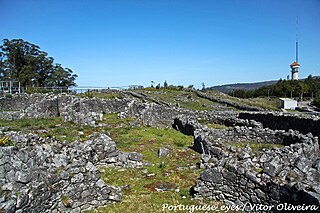 W
WThe Castro de Leceia or Leceia Eneolithic Station is an archeological site of the Castro culture located in the Portuguese civil parish of Barcarena in the municipality of Oeiras. The area was first occupied during the end of the Neolithic and throughout the Chalcolithic, being abandoned somewhere between the end of the 4th and the beginning of the 3rd millennium BCE. The Castro was first dug and reported in 1878 by Carlos Ribeiro, who presented his results to the Lisbon Academy of Sciences in what may be considered the first monograph dedicated to a pre-historical Portuguese settlement. The last interventions date to 2003. The site is classified as a public interest monument since 1963.
 W
WThe Castro of Chibanes is located in the Arrábida Nature Park, on the Serra do Louro, in the municipality of Palmela in the Setúbal District of Portugal, about 25 km (16 mi) south of the capital of Lisbon, which can be seen from the site. The Castro, or hill fort, is located at the top of the hill, naturally defended by a scarp to the south. It covers about one hectare and was first occupied in about 2900 BCE, during the Chalcolithic or Copper Age. It is registered as a Zona Especial de Protecção and also classified as a Sitio de Interesse Público.
 W
WThe Citânia de Briteiros is an archaeological site of the Castro culture located in the Portuguese civil parish of Briteiros São Salvador e Briteiros Santa Leocádia in the municipality of Guimarães; important for its size, "urban" form and developed architecture, it is one of the more excavated sites in northwestern Iberian Peninsula. Although primarily known as the remains of an Iron Age proto-urban hill fort, the excavations at the site have revealed evidence of sequential settlement, extending from the Bronze to Middle Ages.
 W
WThe Citância de Sanfins is an archaeological site of the Castro culture located in the Portuguese civil parish of Sanfins de Ferreira in the municipality of Paços de Ferreira. The construction of the Castro site developed over many phases, between the 5th century BCE and the 2nd century CE. The Castro had a period of Roman occupation that started during the 3rd Century CE, being abandoned during the 4th Century CE. The site also includes a chapel dedicated to Saint Romanus and 34 graves belonging to a Christian cemetery from the Medieval age. The Castro was first dug in 1895 by Francisco Martins Sarmento e José Leite de Vasconcelos and the last interventions were in 1995, when one of the houses was reconstructed and a warrior statue replica was put near the entrance of the second wall.
 W
WThe Citânia de Santa Luzia is an archaeological site of the Castro culture located in the Portuguese civil parish of Areosa in the municipality of Viana do Castelo. Its construction dates from the Iron Age, and it shows evidence of occupation during the Roman period. The Castro was first dug in 1876 by Joaquim Possidonio Narciso da Silva. Only about one third of the structures have been dug, with the remaining part being under or destroyed during the construction of the nearby hotel, church, and respective roads. The site also included a possibly medieval chapel dedicated to Saint Lucy which persisted, after some reconstructions, until 1926 when it was destroyed to give way to the Saint Lucy Church of Miguel Ventura Terra.
 W
WCividade de Terroso was an ancient city of the Castro culture in North-western coast of the Iberian Peninsula, situated near the present bed of the Ave river, in the suburbs of present-day Póvoa de Varzim, Portugal.
 W
WThe Castro of Monte Mozinho is a Neolithic fortified settlement, sometimes referred to as the City of the Dead, situated in the civil parish of Oldrões, in the municipality of Penafiel in the Tâmega Subregion of the Portuguese district of Porto.
 W
WThe Castro of Sacóias is a former fortified settlement and archeological site in the civil parish of Baçal, municipality of Bragança in the Alto Trás-os-Montes subregion of the Portuguese Norte Region.
 W
WThe Castro of Vila Nova de São Pedro is a Chalcolithic archaeological site in the civil parish of Vila Nova de São Pedro, municipality of Azambuja, in the Portuguese Estremadura area of Lezíria do Tejo. It is important for the discovery of thousands of arrowheads within its fortified settlement, associated with the Chalcolithic period of human settlement. associated with the long-lived fortified town, or castro, of Zambujal, near the municipality of Torres Vedras. The period of "urban" settlement lasted from 2600 to 1300 BCE, and was a contemporary of the southeastern Spanish settlements of Los Millares and El Argar.
 W
WThe Castro of Zambujal is a Chalcolithic age archeological site in the civil parish of Santa Maria, São Pedro e Matacães, municipality of Torres Vedras in the western littoral area of the Portuguese Centro Region. The Zambujal Castro is one of the most important Copper Age settlements in the peninsula of Lisbon, and whose culture lasted until the beginning of the agrarian periods of Iberian history. Apart from being the most northerly discovered Copper Age site in Portugal, it went through two main building phases: an import-oriented phase and the second associated with the Beaker culture.